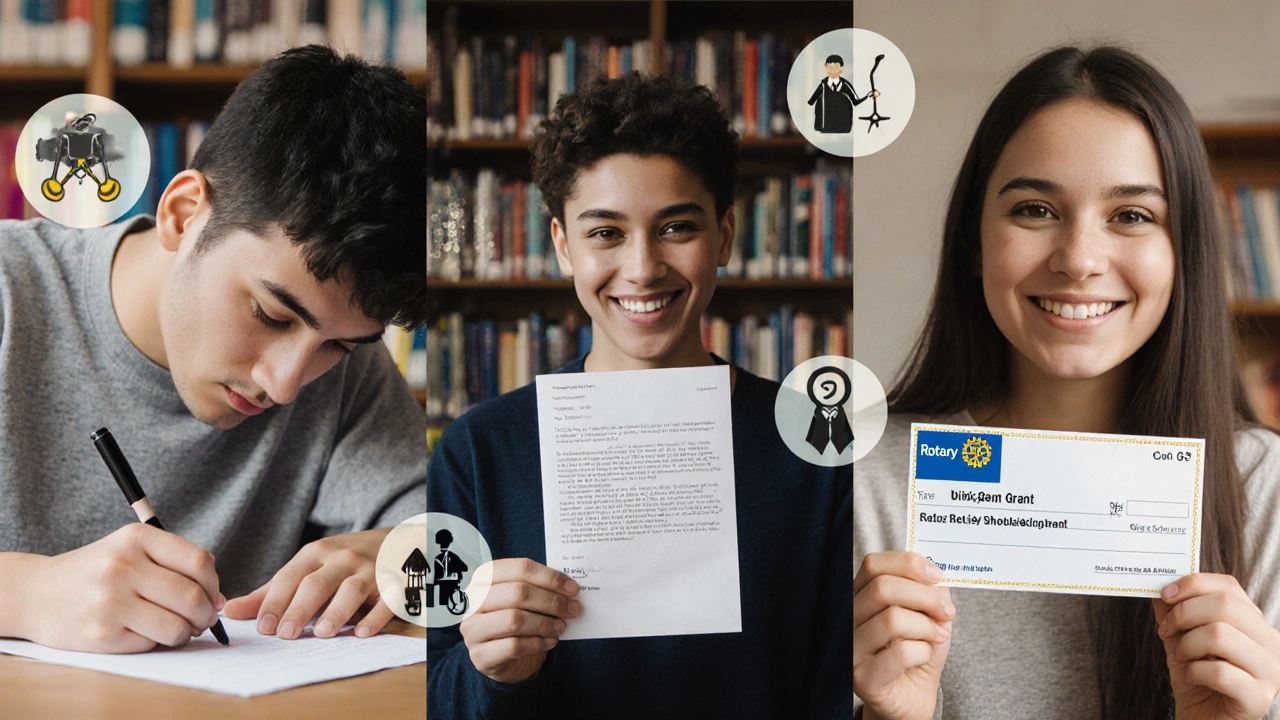Most people think scholarships are for geniuses or athletes with perfect records. That’s not true. The truth? Most scholarships go to regular people who showed up, did the work, and didn’t give up. If you’re wondering how people actually get scholarships, the answer isn’t luck-it’s strategy.
Start with what’s right in front of you
Too many students skip local scholarships because they’re not flashy. But here’s the thing: fewer people apply for them. Your high school, community center, church, or even your parents’ employer might offer $500 to $2,000 scholarships. In 2024, over 40% of all scholarship money in the U.S. and Europe came from local organizations-not big national names.
Check your school’s guidance office. Ask your parents if their company has a scholarship program. Look at community foundations. In Dublin, the Local Enterprise Office gives out annual grants to students pursuing technical courses. In the UK, Rotary Clubs and PTA groups fund dozens of small scholarships every year. These aren’t competitive because they’re not advertised everywhere. You have to go looking.
Write essays that sound like you
Scholarship essays aren’t about perfect grammar or fancy words. They’re about honesty. Adjudicators read hundreds of them. They can tell when someone is copying a template or trying to sound impressive.
One student won a $10,000 scholarship by writing about how she fixed her broken bike with duct tape so she could get to her part-time job. She didn’t talk about grades. She talked about responsibility. Another won by describing how he cooked meals for his younger siblings after his mom worked double shifts. That’s the kind of story that sticks.
Your story doesn’t need to be dramatic. It just needs to be real. Start with: “What’s something people don’t know about me?” Then write like you’re telling a friend.
Apply to scholarships that match your life
Don’t waste time applying for scholarships that require a 4.0 GPA if your average is 3.2. There are hundreds of scholarships for students with B grades, for first-generation college students, for kids from single-parent homes, for people who volunteer at animal shelters, for those who work part-time, for left-handed people (yes, really), and for students who play the ukulele.
Look for niche scholarships. The Jack Kent Cooke Foundation offers scholarships to high-achieving students with financial need, regardless of GPA doesn’t require perfect scores. The National Association of Women in Business gives scholarships to female students pursuing entrepreneurship degrees. The Children of Veterans Scholarship supports kids whose parents served in the military.
Use free tools like Scholarships.com, Fastweb, or The Scholarship Hub to filter by your background, interests, and location. Set up alerts. Check them weekly.
Don’t wait for the perfect moment
People think they need to wait until senior year to apply. Wrong. Many scholarships are open to freshmen and sophomores. Some are even open to middle schoolers. The earlier you start, the more chances you get.
One girl in Belfast started applying in 9th grade. By 12th grade, she had won six small scholarships totaling $8,000. That money paid for her SAT prep course and her application fees. She didn’t win one big scholarship-she won several small ones that added up.
Apply even if you think you’re not qualified. If the scholarship says “open to all high school students,” then you qualify. If it says “students with financial need,” and you’ve ever had to choose between buying books or lunch-you qualify.

Follow instructions exactly
One of the biggest reasons people don’t get scholarships? They don’t read the rules. Missing a signature. Sending the wrong file format. Not including the required essay prompt. These are easy mistakes-and they’re automatic rejections.
Make a checklist for every application:
- Required documents (transcript, letter of recommendation, proof of income)
- Word count for essays
- Deadline (and submit at least 48 hours early)
- Formatting (PDF? Times New Roman? 12pt?)
- Who to send it to (email? portal? postal address?)
One applicant lost a $5,000 scholarship because she emailed her application to the wrong address. The correct one was listed in bold on page 3 of the PDF. She skipped it.
Ask for help-but don’t outsource your voice
It’s okay to ask a teacher, counselor, or older sibling to read your essay. But don’t let them rewrite it. Your voice matters. If your essay sounds like a college professor wrote it, they’ll know. And they’ll reject it.
Instead, ask: “Does this sound like me?” or “Is this clear?” That’s it. Let them point out confusing parts. Don’t let them polish your personality into something generic.
Track everything
Keep a spreadsheet. List each scholarship: name, deadline, amount, requirements, status (applied, pending, awarded, rejected). Add notes like “asked for second letter of recommendation” or “sent follow-up email.”
People who win multiple scholarships aren’t luckier. They’re organized. They don’t forget deadlines. They don’t reapply for the same thing twice. They track what they’ve done.

Rejection isn’t failure-it’s data
You will get rejected. A lot. That’s normal. One student applied to 47 scholarships in her final year. She won 12. That’s a 25% success rate. That’s better than most job interviews.
When you get rejected, ask why. Some programs will tell you. Use that feedback. If they say your essay was too vague, next time, be more specific. If they say your transcript was incomplete, fix it next time.
Every rejection teaches you something. Don’t quit after one no. Keep going.
What about international students?
If you’re from outside the EU or the UK, your options shrink-but they’re still there. Many universities offer scholarships specifically for international students. The Erasmus+ program funds study across Europe. The Chevening Scholarship covers full costs for master’s students from over 160 countries.
Don’t assume you’re locked out. Check the website of every university you’re interested in. Look for “international student funding” or “scholarships for overseas applicants.” Some schools offer automatic scholarships based on your application-you don’t need to apply separately.
Don’t pay for scholarship search services
If someone asks you to pay $50 to access a list of scholarships, walk away. Legitimate scholarships don’t charge application fees. Free databases like Scholarships.com, The Scholarship Hub, and your school’s guidance office already have them.
Scammers know people are desperate. They use fake websites that look real. Always check the domain. Government and university sites end in .gov, .edu, or .ac.uk. If it’s .com and asks for your credit card, it’s a scam.
It’s not about being the best-it’s about being consistent
People who win scholarships aren’t the smartest or the richest. They’re the ones who kept applying. They filled out ten forms when others did two. They wrote essays when others said, “I’ll do it tomorrow.”
Start small. Pick one scholarship this week. Submit it. Then pick another. Build momentum. You don’t need to win a full ride to make a difference. A $1,000 scholarship means one less loan. One less job. One less stress.
Scholarships aren’t a lottery. They’re a system. And systems can be learned. You don’t need to be perfect. You just need to show up.
Can I get a scholarship with bad grades?
Yes. Many scholarships don’t care about GPA at all. They look at financial need, community service, leadership, creativity, or personal challenges. There are scholarships for students who work part-time, care for family members, or overcome hardship. Focus on those instead of the ones that demand straight A’s.
When should I start applying for scholarships?
Start as early as possible-even in middle school. Many scholarships are open to students in grades 9-12. Some are even available to 7th graders. The earlier you begin, the more opportunities you’ll find. Don’t wait until your final year. By then, many deadlines have passed.
Do I need to be in college to get a scholarship?
No. Many scholarships are for high school students planning to attend college. Others are for students entering vocational training, apprenticeships, or gap years. Some even support adults returning to education. Check the eligibility requirements carefully-many are open to non-traditional students.
How many scholarships should I apply for?
Apply to as many as you can reasonably manage. Quality matters more than quantity, but applying to 10-20 scholarships per month is realistic for most students. Even small awards add up. A $500 scholarship here, $750 there-over a year, that’s thousands.
Are scholarships taxable?
In most cases, no. If the money is used for tuition, books, and required supplies, it’s not taxable. But if you use it for room and board or personal expenses, part of it may be taxable. Always check the rules from your country’s tax authority. In Ireland and the UK, scholarships for education are generally tax-free.
Can I get multiple scholarships at once?
Yes. Most schools allow you to stack scholarships unless they say otherwise. Some even encourage it. But check with your university-some have caps on total aid. Even so, combining smaller awards can cover most or all of your costs.
What if I don’t win any scholarships?
Keep trying. Many students win scholarships in their second or third year of college. Look for renewal scholarships that reward continued performance. Also, consider work-study programs, part-time jobs on campus, or employer-sponsored tuition help. Scholarships aren’t the only path-just one of the most powerful.
If you’re serious about funding your education, stop waiting for someone to give you a scholarship. Start applying. One form at a time. One essay at a time. The money is out there. You just have to reach for it.
